Click below to jump to an article of interest.
SwRI-UTSA Connect Through Research
SwRI and The University of Texas at San Antonio (UTSA) announced two new Connecting through Research Partnerships (Connect) projects, each receiving $125,000 in funding. One project will research using a new class of DNA-based tracers to map groundwater resources. The other will investigate an implant designed to deliver a controlled dose of medicines.
“The Connect projects selected this year deal with human health and critical resources,” said SwRI Executive Vice President and COO Walt Downing. “UTSA faculty and graduate students working together with SwRI scientists and engineers will develop innovative technologies to improve disease therapies and to protect water resources.”
The Connect program enhances scientific collaboration between SwRI and UTSA and increases their research funding base. Since 2010, the joint SwRI-UTSA Connect Program has funded 15 projects.
Detecting Contamination Sources with DNA
One SwRI-UTSA team is developing new DNA-based tracers to map the flow path of the Edwards Aquifer. The tracers, made of environmentally safe capsules that store a synthetic double-stranded DNA, will help detect the sources of aquifer contamination. Because DNA is made of the four basic molecules that can be combined in any random order, the DNA-based tracer system allows for the fabrication of thousands of unique tracers,” said Dr. Vikram Kapoor of UTSA’s College of Engineering.
The Edwards Aquifer is the primary water source for a vast number of people living in Central and South Texas. As a naturally occurring water resource, it’s vulnerable to contamination from storm water runoff, leaking septic tanks and municipal waste. When contamination occurs, it’s vital to detect the source quickly, which can be challenging.
“It’s very difficult to discern flow paths in the Edwards Aquifer,” said Dr. Ronald Green of SwRI’s Space Science and Engineering Division. “The aquifer is made up of limestone, which has partially dissolved over time, creating a honeycomb structure that makes it impossible to visually identify the water’s path.”
The DNA tracers will make this task easier. They will be released at different points in the aquifer, and water samples will be collected and examined. The team will note which tracer and unique DNA have appeared at each sample location to determine their path through the aquifer. The SwRI-UTSA team will also use the information to create a robust database to calibrate surface water and groundwater modeling and to support other hydrogeological studies.
3D Therapy
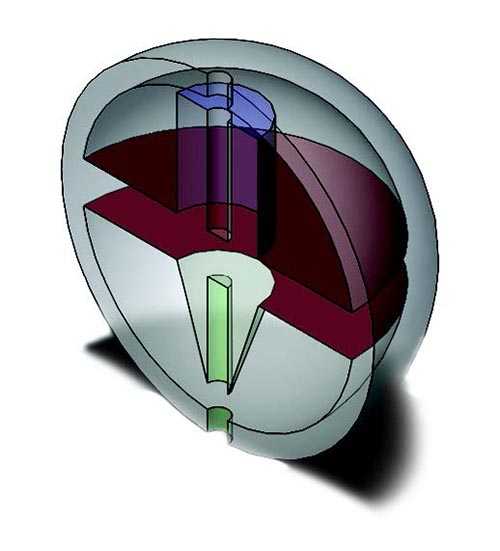
SwRI and UTSA are collaborating to create the 3D-printed, biodegradable device illustrated here to allow a personalized medicine approach to treating a variety of illnesses. Implanted for localized delivery, the device uses specialized geometric shapes to control drug release and dissolves after treatment.
Patients with chronic illnesses like cancer, AIDS and arthritis could one day get personalized doses of medicine through a 3D-printed device implanted in their bodies. SwRI and UTSA are collaborating on an implant designed to deliver a controlled dose of medicine directly to a treatment site, such as a cancerous tumor.
“The implant addresses a specific patient’s illness in addition to their medical history and other health issues,” said Albert Zwiener of SwRI’s Chemistry and Chemical Engineering Division. “We inject this noninvasive device into the body to deliver medicine over a significant period of time.”
The implant is engineered to trigger localized immunotherapy, enlisting the body to attack cancers. The SwRI-UTSA team believes that the device’s localized treatment capabilities can trigger the body to destroy invasive cancer.
“In immunotherapy, most strategies employ systemic circulation through an IV line, much like chemotherapy. This can cause issues with immune reactions far away from the intended target,” said Dr. Lyle Hood of UTSA’s College of Engineering. “We hope that by delivering locally, we can keep acute effects constrained to the diseased region.”
The team will use a specialized 3D printer that can output biodegradable materials. This makes implant removal unnecessary, as it will simply dissolve inside the body when the treatment is complete.
While the implant is ideal for cancer treatment, it’s designed to be drug agnostic, meaning that it can work with any type of drug and could have a significant impact on a wide array of diseases and ailments.
Parker Solar Probe
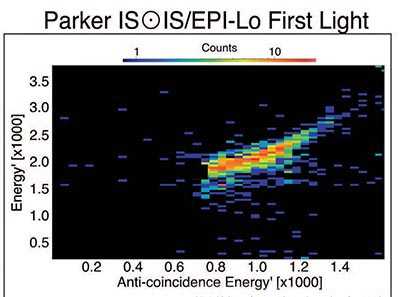 Image Courtesy of NASA
Image Courtesy of NASA Just over a month into its mission, Parker Solar Probe returned first-light data from its instruments. EPI-Lo’s initial data (top) show background cosmic rays, particles energized and rocketed into our solar system from elsewhere in the Milky Way. As PSP gets closer to the Sun, instruments will operate at full power and scientists will see more solar energetic particles accelerated in bursts and streaming from the Sun and corona. EPI-Hi (bottom) detected both hydrogen and helium particles from its lower-energy telescopes. Once nearer to the Sun, the instrument will also detect heavier elements and particles with much higher energies, especially during solar energetic particle events.
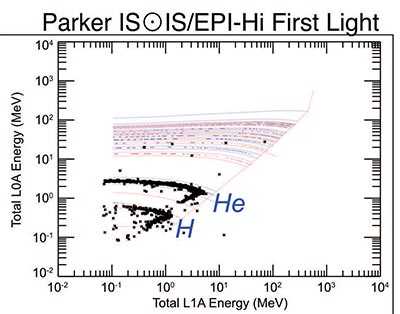 Image Courtesy of NASA
Image Courtesy of NASA NASA’s Parker Solar Probe (PSP) launched Aug. 12 on a journey into the Sun’s atmosphere, or corona, carrying hardware SwRI helped develop. Scientists will probe the enigmatic features of the Sun to answer many questions, including how to protect space travelers and technology from the radiation associated with solar events.
”Our main goal is to determine the acceleration mechanisms that create and transport dangerous high-energy particles from the solar atmosphere into the solar system,” said Dr. Mihir Desai, a mission co-investigator managing the Integrated Science Investigation of the Sun (ISʘIS) instrument suite. ISʘIS consists of two instruments, Energetic Particle Instrument-High (EPI-Hi) and Energetic Particle Instrument-Low (EPI-Lo). “Once EPI-Hi and EPI-Lo measure these particles, we will discover how they are related to the solar wind and coronal structures that are observed by the other three instruments on PSP.”
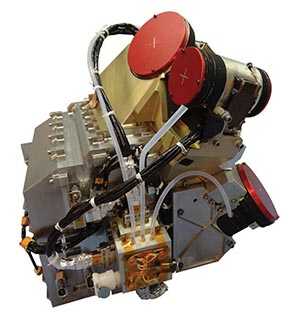 Image Courtesy of NASA
Image Courtesy of NASA SwRI engineers worked with Caltech to build and analyze the PSP EPI-Hi instrument, designed to measure higher energy solar materials.
PSP will get within 4 million miles of the Sun’s surface, facing unprecedented heat and radiation. It will collect new data on solar activity to help scientists understand the mystery of how the solar atmosphere is so much hotter than the surface of the Sun itself. It will also make critical contributions to forecasting major solar events that impact life on Earth. Coronal mass ejections and solar flares peak roughly every 11 years. They release huge quantities of energized matter, magnetic fields and electromagnetic radiation into space.
“The sea of materials coming from the Sun is essentially smeared by the time it arrives at Earth,” Desai said. “We can’t tell how particles are selected and accelerated to higher energies, and we can’t tell if interplanetary turbulence and large-scale solar wind structures affect their transport to Earth orbit.” The solar energetic particles (SEPs) present a serious radiation threat to human explorers living and working outside low-Earth orbit and to technological assets such as communications and scientific satellites in space. The mission will make the first-ever direct measurements of both the low-energy source populations as well as the more hazardous, higher-energy particles in the near-Sun environment, where the acceleration takes place.
The ISʘIS instrument suite has two instruments mounted to the spacecraft on an SwRI-designed and -fabricated bracket. The EPI-Lo instrument measures the lower-energy particles. SwRI collaborated with Caltech in the mechanical fabrication and analyses for the EPI-Hi instrument, which measures the higher-energy materials.
“By measuring the full range of energetic populations and correlating the data with other measurements, we hope to get a clear picture of the origin and acceleration processes,” Desai said. “We will also integrate the data into models to better understand the origin of SEPs and other materials. Parker Solar Probe will answer so many questions — and is guaranteed to generate some new ones as well.”
Ultima Thule Ready for Its Jan. 1 Close-up
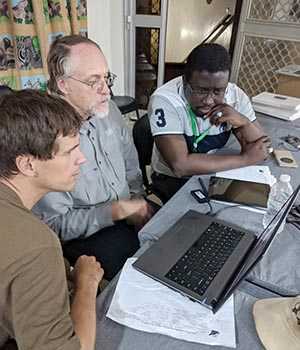 Image Courtesy of NASA/Johns Hopkins University Applied Physics Laboratory/SwRI/Anne J. Verbiscer
Image Courtesy of NASA/Johns Hopkins University Applied Physics Laboratory/SwRI/Anne J. Verbiscer Above, occultation expedition leader Dr. Marc Buie (center), flanked by an international team, gets his first look at the stellar occultation of Ultima Thule from Louga, Sénégal.
Despite clouds and rain, oppressive heat and humidity, and myriad logistical challenges, a NASA science team in Sénégal saw what they came to see on Aug. 4.
The next flyby target for New Horizons, an ancient Kuiper Belt object nicknamed Ultima Thule, passed in front of a star and momentarily blocked its light. This brief obstruction of starlight, called an occultation, provided information about the object’s size, shape and hazard environment.
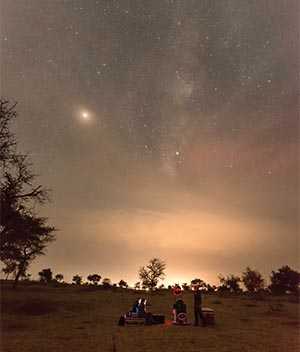 Image Courtesy of NASA/Johns Hopkins University Applied Physics Laboratory/SwRI/Anne J. Verbiscer
Image Courtesy of NASA/Johns Hopkins University Applied Physics Laboratory/SwRI/Anne J. Verbiscer The telescope team led by SwRI’s Dr. Cathy Olkin waits for the occultation in Senegal, hoping to catch the moment a star winks out, indicating that Ultima Thule has passed in front of it. The New Horizons team uses these “occultations” to learn more about the mysterious object in advance of a historic encounter Jan. 1.
“Personnel and logistical support came from around the globe. We owe the success of these observations in large part to this amazing, multinational collaboration,” said SwRI’s Marc Buie, New Horizons occultation expedition leader. “This work is in preparation for our next New Horizons flyby, coming up fast on Jan. 1. We expect to learn much more about Ultima Thule by examining it up close.”
For this occultation, as well as a similar one in July 2017, NASA’s Hubble Space Telescope probed the region around Ultima for potentially hazardous rings or debris.
“This year the Hubble Telescope was in a much better position and could probe for rings down to around 1,000 miles altitude,” said New Horizons team member Josh Kammer, of SwRI. “There were no detectable ring signatures for either event, so using the Hubble data we were able to set important constraints on the presence of any rings or dust that could jeopardize a safe flyby.”
Ancient Kuiper Belt objects like Ultima Thule hold clues to the formation of planets and the “third zone” of our solar system where they reside, beyond the giant planets. Ultima Thule, officially known as 2014 MU69, orbits the Sun from more than a billion miles beyond Pluto. The New Year’s Day flyby will be the first ever exploration of such a body and the farthest planetary encounter in history.
Follow New Horizons on its voyage at pluto.jhuapl.edu.
Binary Pair Point to Early Solar System Shake-up
SwRI scientists studied an unusual pair of asteroids and discovered that their existence points to an early planetary rearrangement in our solar system. These bodies, called Patroclus and Menoetius, are targets of NASA’s upcoming Lucy mission. They are around 70 miles wide and orbit around each other as they collectively circle the Sun. They are the only known large binary in the population of ancient bodies referred to as the Trojan asteroids. The two swarms of Trojans orbit at roughly the same distance from the Sun as Jupiter, one swarm orbiting ahead of, and the other trailing behind, the gas giant.
“The Trojans were likely captured during a dramatic period of dynamic instability when a skirmish between the solar system’s giant planets — Jupiter, Saturn, Uranus and Neptune — occurred,” said SwRI Institute Scientist Dr. David Nesvorny. This shake-up pushed Uranus and Neptune outward, where they encountered a large primordial population of small bodies thought to be the source of today’s Kuiper Belt objects, which orbit at the edge of the solar system. “Many small bodies of this primordial Kuiper Belt were scattered inward, and a few of those became trapped as Trojan asteroids.”
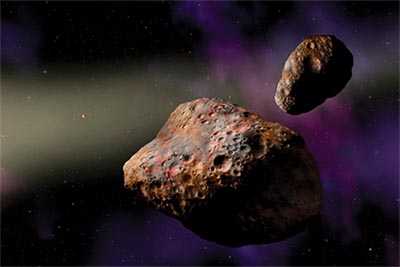 Image Courtesy of W.M. Keck Observatory/Lynette Cook/NASA/JPL-CALTECH
Image Courtesy of W.M. Keck Observatory/Lynette Cook/NASA/JPL-CALTECH SwRI scientists studied the binary asteroid Patroclus-Menoetius, shown above in this artist’s concept, to determine that a shake-up of the giant planets likely happened within the first 100 million years of the solar system’s history.
A key issue with this solar system evolution model, however, has been when it took place. In a recently published paper, scientists demonstrate that the very existence of the Patroclus-Menoetius pair indicates that the dynamic instability among the giant planets must have occurred within the first 100 million years of solar system formation.
“Observations of today’s Kuiper Belt show that binaries like these were quite common in ancient times,” said Dr. William Bottke, director of SwRI’s Space Studies Department. “Only a few of them now exist within the orbit of Neptune. The question is how to interpret the survivors.”
Had the instability been delayed many hundreds of millions of years, as suggested by some solar system evolution models, collisions within the primordial small-body disk would have disrupted these relatively fragile binaries, leaving none to be captured in the Trojan population.
This work underscores the importance of the Trojan asteroids in illuminating the history of our solar system. Much more will be learned about the Patroclus-Menoetius binary when NASA’s Lucy mission, led by SwRI scientist and paper coauthor Dr. Hal Levison, surveys the pair in 2033, culminating a 12-year tour of both Trojan swarms.
This research was featured in the paper “Evidence for Very Early Migration of the Solar System Planets from the Patroclus-Menoetius Binary Jupiter Trojan,” published in Nature Astronomy. NASA’s Solar System Exploration Research Virtual Institute (SSERVI) and Emerging Worlds programs, as well as the Czech Science Foundation, funded this work. Lucy is a Discovery class mission managed by NASA’s Goddard Space Flight Center in Greenbelt, Maryland.
Resource Reconnaissance
SwRI scientists are investigating using the latest remote-sensing technology to assess groundwater recharge more accurately. Groundwater collects in the cracks and spaces in soil, sand and rock. It supplies drinking water for about half of the U.S. population, including 99 percent of the rural population. Resources are replenished or recharged by precipitation moving slowly through geologic formations called aquifers.
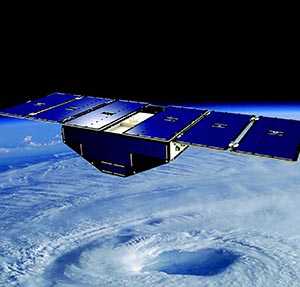 Image Courtesy of University of Michigan
Image Courtesy of University of Michigan Scientists are investigating using the SwRI-developed CYGNSS satellite constellation to study groundwater recharge.
“When managing groundwater resources, particularly in more arid environments, the greatest uncertainty lies in calculating recharge rates,” said Dr. Ronald Green, a groundwater hydrologist at SwRI. “Improvements in data acquisition and interpretation will improve recharge estimates. This is particularly important in drier regions where water demand is rapidly outpacing availability.”
Measuring recharge is difficult. Scientists have used various surface-based techniques to evaluate, model and infer recharge. Increased availability of remotely sensed data from multiple satellite platforms could allow scientists to estimate recharge more precisely.
“Hilly topography and arid environments pose special challenges and opportunities for remote-sensing applications,” said co-investigator Dr. Stuart Stothoff. “Using the Google Earth Engine, we combine precise elevation models, optical data and the Sentinel-1 satellite’s two- and three-dimensional images of landscapes.”
The SwRI team also integrates data from an existing satellite system, the Soil Moisture Active Passive (SMAP) platform, and the recently deployed Cyclone Global Navigation Satellite System (CYGNSS). The SMAP observatory measures the amount of water in the top 2 inches of soil. While designed to measure ocean winds during hurricanes, the SwRI-built CYGNSS constellation also makes measurements over land. These data might prove complementary to SMAP measurements.
Cobot Coworkers
SwRI has launched a Collaborative Robotics Laboratory featuring collaborative robots or “cobots.”
While conventional industrial robots are typically walled off from humans for safety, cobots are different. They work alongside human operators performing manual tasks and heavy lifting. SwRI develops deep-learning algorithms, perception technologies and advanced path planning capabilities that enable cobots to collaborate with humans while performing multiple tasks.
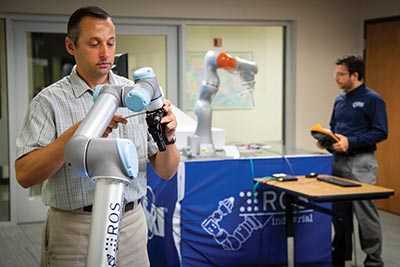
“Cobots, when combined with adaptive perception-rich software, can perform complex tasks safely next to humans,” said Paul Evans, director of SwRI’s Manufacturing and Robotics Technologies Department. “Demand for SwRI’s technical expertise in these areas inspired this capital investment in next-generation robotics.”
Engineers use the new robotics lab as a test bed for software development, working in close proximity to smaller cobots, before porting advanced capabilities to larger industrial robots. The SwRI-managed ROS-Industrial Consortium also uses the lab for open-source Robot Operating System (ROS) projects, including a robotic arm that fuses markerless motion capture technology with machine learning to autonomously pick and place objects from human hands.
SwRI’s Collaborative Robotics Laboratory will support client projects, internal research, industry workshops, software development and manufacturing.
Navigating the FDA
How does a new drug get Food and Drug Administration (FDA) approval? SwRI hosted a one-day workshop Oct. 8 to address the concepts, strategies and tools needed to successfully submit investigational new drugs (IND) to the FDA.
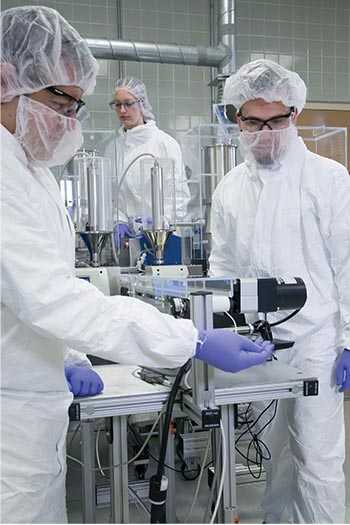
SwRI’s “Small Molecule Drug Development: From Concept to IND” one-day course delved into the chemistry, manufacturing and control (CMC) and nonclinical decisions needed to support IND submission. Proper CMC and decisions during development can critically affect IND approval from the FDA. IND approval is needed for new drugs to start clinical trials and ultimately enter the market.
“The process of bringing a small-molecule drug to market is complex. In addition to presentations based on actual IND experiences and a tour of SwRI’s CGMP (Current Good Manufacturing Practices) manufacturing facility, the course offered a real-world group exercise to help participants practice tackling drug development issues,” said Varsin Archer, a research scientist in SwRI’s Chemistry and Chemical Engineering Division. “Drugs can fail IND submission if the CMC quality and process do not meet standards and regulations.”
Participants worked with experienced staff in the pharmaceutical and drug development area and learned about the challenges, decision processes and tools used to ensure smoother IND submissions. The course also covered technical transfer, formulation and analytical development, CGMP manufacturing, safety and costs. Twenty participants attended the workshop, designed for beginner to intermediate professionals.
AC2AT™ Emission Technology Innovations
SwRI is launching the second phase of the Advanced Combustion Catalyst and Aftertreatment Technologies consortium — AC²AT-II — focusing on engine emissions solutions and innovative catalyst technologies.
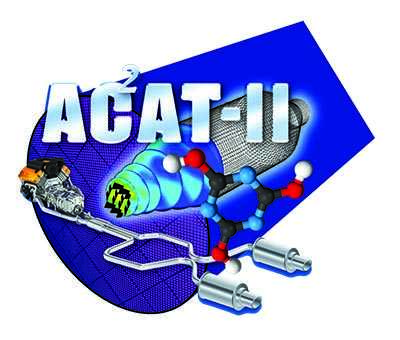
SwRI initiated the AC²AT consortium in 2014 with members representing engine manufacturers and affiliated businesses in the automotive industry. AC²AT research focused on improving the understanding of catalysts and emission control systems, modeling those systems and characterizing the emissions produced by advanced combustion regimes.
“In the first phase, AC²AT made considerable advances in understanding how complex emissions control systems affect today’s high-performance, high-efficiency gasoline and diesel engines,” said Scott Eakle, a principal engineer in SwRI’s Diesel Engine and Emissions Research and Development Department. The second phase will continue advances made in the first phase. These include new models developed to understand how the properties of lube oil-derived ash affects aftertreatment performance and to predict deposit formation, growth and composition in aftertreatment systems.
SwRI is a leader in managing vehicle research consortia, which allow members to collaborate to advance the state of the art in gas, diesel and electric vehicles. The AC²AT-II consortium allows companies to share costs, supporting more advanced combustion and novel catalyst research than would be feasible if funded individually. AC²AT-II participants will decide which research projects to investigate and receive royalty-free licensing for all intellectual property the consortium produces.
For more information about the AC²AT-II consortium, contact Eakle at 210.522.5095 or visit consortia.swri.org.
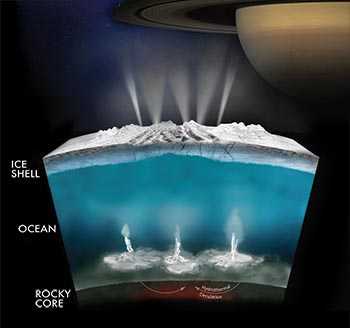 Image Courtesy of NASA.JPL Space Science Institute
Image Courtesy of NASA.JPL Space Science Institute SwRI scientists found large, carbon-rich molecules in the icy jets of Saturn’s moon Enceladus. These plumes send particles from its subsurface ocean streaming into space hundreds of kilometers above cracks in the ice at its south pole.
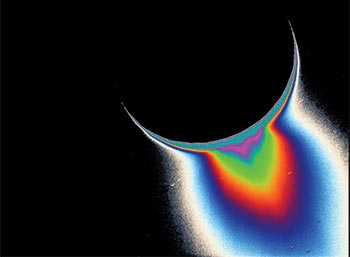 Image Courtesy of NASA.JPL Space Science Institute
Image Courtesy of NASA.JPL Space Science Institute Ingredients for Life in Enceladus
SwRI scientists are part of a team that discovered complex molecules in geysers spewing from Saturn’s moon, Enceladus. These large, carbon- rich organic molecules indicate that the moon could have the potential to support life.
“We are, yet again, blown away by Enceladus. We’ve found organic molecules with masses above 200 atomic mass units. That’s over 10 times heavier than methane,” said Dr. Christopher Glein, an SwRI space scientist specializing in extraterrestrial chemical oceanography. He is coauthor of a paper in Nature outlining this discovery. “With complex organic molecules emanating from its liquid water ocean, this moon is the only body besides Earth known to simultaneously satisfy all of the basic requirements for life as we know it.”
Scientists found the molecules using mass spectrometry data from NASA’s Cassini spacecraft, which sampled the plume of material emerging from the subsurface of Enceladus. The Cosmic Dust Analyzer (CDA) and the SwRI-led Ion and Neutral Mass Spectrometer (INMS) made measurements within both the plume and Saturn’s E-ring, which is formed by plume ice grains escaping Enceladus’ gravity. INMS previously also detected molecular hydrogen in Enceladus’ plume.
“Hydrogen provides a source of chemical energy supporting microbes that live in the Earth’s oceans near hydrothermal vents,” said SwRI’s Dr. Hunter Waite, the INMS principal investigator who also coauthored the Nature paper. “Once you have identified a potential food source for microbes, the next question to ask is ‘What is the nature of the complex organics in the ocean?’”
The paper, “Macromolecular organic compounds from the depths of Enceladus,” was published in the June 28, 2018, issue of Nature.
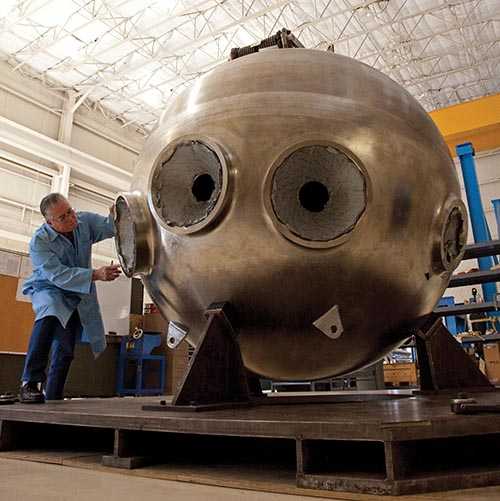
SwRI designed and built the pressure hull for the Alvin research submersible, allowing it to reach over 90 percent of the ocean floor. SwRI specializes in the design and construction of pressure hulls and other marine systems.
Underwater Endeavors
SwRI engineers are continuing our long history of undersea vehicle research and development activities. The Institute is one of 23 organizations recently awarded a contract for the U.S. Navy valued up to nearly $800 million over the next five years.
“SwRI has extensive experience providing innovative services in ocean engineering and subsea research,” said Joe Crouch, program director of Marine and Offshore Systems at SwRI. “Our expertise in the construction of marine structures, such as low-cost, high-quality pressure hulls, is particularly beneficial to this Navy program.”
The contract is an indefinite delivery, indefinite quantity (IDIQ) award, a contract vehicle that funds work tasks over specified periods of time — five years, in this case. The IDIQ supports the procurement of materials and services used to develop, build, fabricate and support the Navy’s unmanned undersea family of vehicles.
Calibration Accreditation
SwRI’s particle emissions laboratory is now the only facility fully accredited by the American Association for Laboratory Accreditation (A2LA) for calibrating equipment to ISO/IEC 17025. SwRI is qualified to calibrate devices that measure and quantify particle number and size as small as 10 nanometers in diameter.

SwRI is now the only organization accredited by A2LA to calibrate devices to the full cadre of national and international particle emissions specifications, using a suite of particle instruments.
“SwRI has pioneered measuring and characterizing fine, ultrafine and nanoparticle emissions,” said Dr. Imad Khalek, a leading expert in particle emissions R&D at SwRI. “The industry is deploying particle sensor systems to accurately measure particle mass and number in emissions. This is critical to understanding the pollutants emitted by cars, trucks and airplanes, to name a few sources.”
Of particular recent interest are health concerns associated with solid particles emitted from combustion sources including automotive and aircraft engines. Particle number (PN) is now regulated in the European Union, China and India, and PN measurements are used in emissions research and engine certification applications worldwide. The instruments needed to perform PN measurement require special calibrations involving particle size and number. SwRI now provides such calibrations for:
- Particle sizers in accordance with ISO 15900
- Particle counters in accordance with ISO 27891
- Particle number measurement systems for automotive applications in compliance with United Nations Economic Commission for Europe UNECE R49 and 83
- Particle number measurement systems for aircraft applications in compliance with the International Civil Aviation Organization and Society of Automotive Engineers SAE AIR6241
“We are now the only laboratory able to perform both ISO-compliant calibration and standardized testing that conforms to standards in the U.S. and abroad,” Khalek said. “These accreditations cement our research and innovation leadership in the industry.”
SwRI’s state-of-the-art particle calibration laboratory includes instruments to measure particle number, surface area, mass, size and morphology. The facility also houses an SwRI-developed universal particle generator that can generate soot, semi-volatile hydrocarbons, sulfate and nitrate for particle research and instrument calibration.
For more information, go to: swri.org/particle-science.
War on Malaria
SwRI is developing new technology to lower the cost of artemisinin, the primary drug used to treat malaria. The Institute received a Bill & Melinda Gates Foundation grant of $267,870 to combat the mosquito-borne disease. Worldwide, malaria causes more than 400,000 deaths and 200 million medical visits annually, according to the World Health Organization.
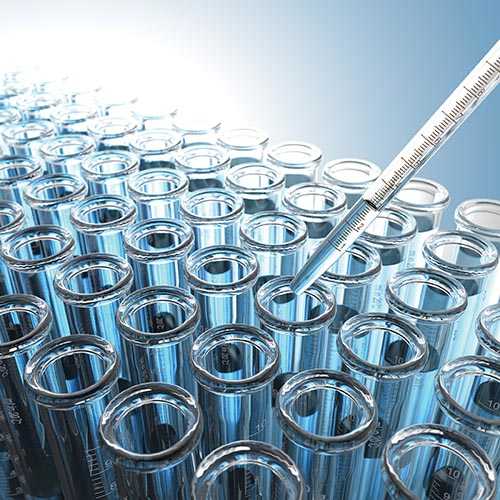
While artemisinin-based combination therapies (ACT) are more than 90 percent effective at treating the disease, the cost of treatment exacts a heavy financial burden in the regions most heavily stricken.
“Malaria remains one of the oldest known diseases to plague humans. We will be working to develop a new chemistry technique to develop artemisinin treatment,” said Dr. Shawn Blumberg, a research scientist in SwRI’s Chemistry and Chemical Engineering Division. “We think this concept will deliver a viable, lower-cost artemisinin to inexpensively address one of humanity’s most deadly infectious diseases.”
Currently, artemisinin is extracted from the sweet wormwood plant, which takes around eight months to mature and yields about 15 grams of artemisinin for every kilogram of plant. Previous efforts to lower the cost of artemisinin involved the use of bioengineered yeast to produce artemisinic acid (AA), a synthetic precursor of the drug. This process, however, has yet to replace sweet wormwood as the primary source of the drug. SwRI is developing a novel process to use the more abundant Amorpha-4, 11-diene (AMD) as a cost-effective starting material to make high-quality, semisynthetic artemisinin.
SwRI is collaborating with Dr. Doug Frantz from The University of Texas at San Antonio on this potentially life-saving therapeutic.
Safe Connections
SwRI has introduced new hardware and software tools to help make vehicles safer. Connected vehicles (CVs) use wireless communication to share information between vehicles and infrastructure to improve safety and mobility.

SwRI’s comprehensive CV test tool suite verifies compliance with SAE International’s performance requirements for vehicle-to-vehicle safety communications. The SAE standards ensure interoperability and data integrity when devices communicate over wireless networks.
“This suite of tools will verify that connected vehicle devices perform as expected for deployment in vehicles and along public roads,” said Eric Thorn, manager of SwRI’s Cooperative Systems Section.
The SwRI Connected Vehicle Test Tool evaluates all vehicle-level requirements with data collection, data analysis, reporting software tools and all required hardware in a simple, portable package. It generates an easy-to-follow summary report for each requirement evaluated. SwRI is making the test tool suite available to clients for purchase, but SwRI also offers testing services for interested vendors with connected vehicle devices.
Cool Turbine Design Extends Life of Drones
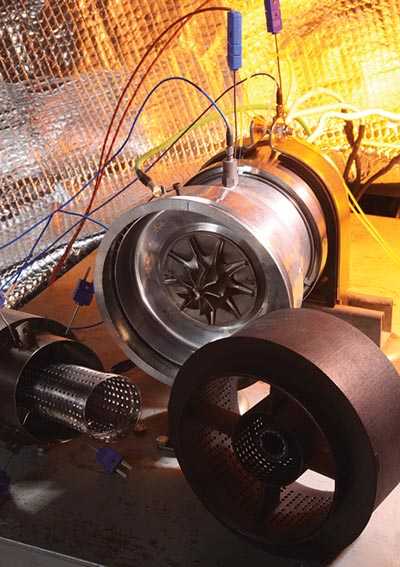
SwRI is developing a new radial gas turbine generator to provide thousands of hours of power for a hybrid unmanned aerial vehicle (UAV). This “cooled” design offers a significant improvement over current UAV technology that requires maintenance after several hundred hours.
“The turbine is similar to those in portable generators used to power your house in emergencies,” said David Ransom of SwRI’s Mechanical Engineering Division. “But the version we created is more compact and quiet, tailored to the needs of small, unmanned aircraft.”
Turbines are rotary devices that can mechanically drive a generator to produce electrical power. The problem with current designs is that the combustion process bathes the turbine in high-temperature gas that ultimately damages or destroys it.
“The hotter the turbine gets, the better it performs,” Ransom said. “But these smaller turbines can’t survive the heat long term. Our design has tiny airflow passages that cool the turbine, permitting hotter gas temperatures.”
Similar airflow passages are common in large high-temperature turbines used in power plants and passenger airplanes. To create the intricate airflow design for a small turbine, engineers are using a new selective laser melting (SLM) machine. Unlike other 3D printers, the SLM machine builds highly detailed parts layer by layer from metal rather than plastic.
“Normally with small turbines, you have to make a choice between performance and reliability,” Ransom said. “Our goal is to make it possible to have both.”
Database for Stellar-Exoplanet Exploration
Stellar chemistry hints at composition, potential habitability of alien worlds
An SwRI scientist is using big data to help the scientific community characterize exoplanets, especially alien worlds orbiting nearby stars. Of particular interest are exoplanets that could harbor life.
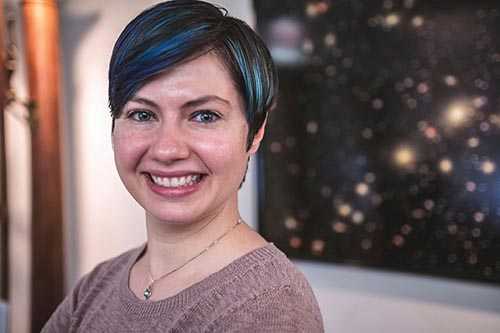
SwRI’s Dr. Natalie Hinkel created the Hypatia Catalog to help scientists connect the elements in nearby stars with the compositions of orbiting exoplanets to better understand potential habitability.
“At first, scientists focused on temperatures, looking for exoplanets in the ‘Goldilocks zone’ — neither too close, nor too far from the star, where liquid water could exist,” said Dr. Natalie Hinkel, a planetary astrophysicist at SwRI. “But the definition of habitability is evolving beyond liquid water and a cozy temperature.”
The planets also need the building blocks for life (such as hydrogen, carbon, nitrogen, oxygen and phosphorus) as well as a rocky composition (including elements such as iron, silicon and magnesium) for a planet to be habitable. Active geochemical cycles and a protective atmosphere are also considered optimal.
“With current technology, we can’t measure the composition of an exoplanet’s surface, much less its interior,” Hinkel said. “But we can measure the abundance of elements in a star spectroscopically, studying how light interacts with the elements in a star’s upper layers. Using these data, scientists can infer what a star’s orbiting planets are made of, using stellar composition as a proxy for its planets.”
Hinkel built a publicly available database, called the Hypatia Catalog, to help researchers explore thousands of stars, as well as potential star-exoplanet systems, observed over the last 35 years. It’s the largest database of stars and their elements for the population within 500 light years of our Sun. At last count, Hypatia had stellar chemical abundance data on 6,156 stars, 365 of which are known to host planets. The database also catalogs 72 stellar elements from hydrogen to lead. Hinkel named the catalog after one of her scientific heroines, a leading mathematician and astronomer in the late 300s, early 400s — the only woman known to have had this level of scientific influence in her time.
For more information, please see swri.org/astrophysics or hypatiacatalog.com.

SwRI, CRIEPI Extend 20-Year Collaboration
On Oct. 3, SwRI extended a 20-year agreement with the Central Research Institute of Electric Power Industry (CRIEPI) in Tokyo, Japan, for an additional five years. The collaboration allows SwRI to support CRIEPI efforts to provide technology and services to member utilities, such as development of advanced inspection technology and more efficient, environmentally friendly energy sources.
SwRI Scientists Discover Downpour at Saturn
Using some of the Cassini spacecraft’s final measurements, Southwest Research Institute scientists have discovered that complex organics rain down from Saturn’s rings into its upper atmosphere. Cassini’s final orbits allowed instruments to sample particles in the ring environment, discovering that the inflow of water and other material is much heavier than expected.
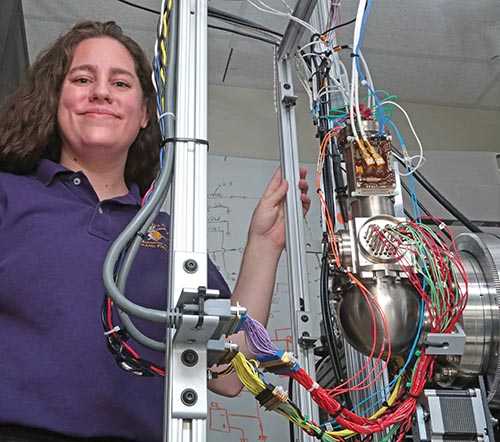
The SwRI team, including INMS operations lead Rebecca Perryman, analyzed and interpreted “ring rain” measurements collected during Cassini’s final orbits around Saturn. The team used experimental data from this engineering model of the INMS instrument for calibration and verification.
“For its final adventure, Cassini dove into the unknown region between Saturn’s rings and its atmosphere,” said SwRI’s Dr. Kelly Miller, who coauthored the paper “Chemical interactions between Saturn’s atmosphere and its rings” published Oct. 4 in the journal Science. “Based on previous work, scientists expected material was raining from the rings into Saturn’s atmosphere, so the spacecraft used its radio antenna as an umbrella to protect it from debris.”
After almost 20 years in space and 13 years in the Saturn system, the Cassini spacecraft was running out of fuel. NASA decided to use its last orbits to study the upper atmosphere and the edge of the inner rings before taking its final destructive dive into the planet’s atmosphere in September 2017.
“Turns out, ring rain is more like a ring downpour,” said SwRI’s Dr. Hunter Waite, the paper’s lead author and principal investigator of Cassini’s Ion and Neutral Mass Spectrometer (INMS).
The team found that molecular hydrogen was, as expected, the most abundant constituent of Saturn’s atmosphere. However, the infalling material also contained methane, nitrogen, and carbon monoxide gases, as well as water, ammonia and carbon dioxide ices mixed with complex organic molecules.
“The large mass of infalling material has implications for ring evolution, hinting that material from the C ring repeatedly replenishes the neighboring D ring,” Waite said. “This infalling material likely affects the atmospheric chemistry and the carbon content of Saturn’s ionosphere and atmosphere.”

